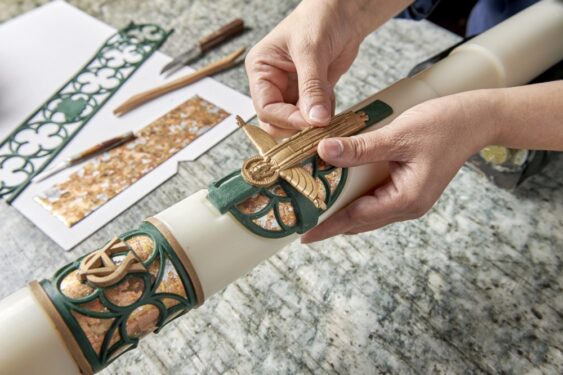
WASHINGTON — The paschal candle has its moment to shine, literally, in the Easter Vigil Mass.
The Mass, which starts outdoors in the evening, begins with the lighting of the paschal candle from a fire, representing the light of Christ coming into the world and dispelling darkness. The candle’s flame is then passed on to candles held by those in the congregation who enter the darkened church with their light.
Once the church is full, the lights are turned on for the reading or chanting of a special Easter proclamation, or Exsultet. The prayer refers to the light that dispels all evil and also credits those who crafted the candle and the work of the bees in forming the candle’s beeswax.
The rich symbolism of darkness to light is not lost on Mark Steigerwald, vice president of the Cathedral Candle Company in Syracuse, New York, a fourth-generation family business that is one of the leading suppliers of church candles in the U.S.
He said the factory workers who craft the paschal candles, steeped in religious symbolism, similarly appreciate the importance of their product, which is why he thinks most of the employees, all unionized, have been at the factory for several decades and every one of them came back after the operation closed for two months in 2020 during the pandemic.
The factory, which also makes other liturgical and devotional candles, was started by Steigerwald’s great grandfather Jacob Steigerwald in 1897 who learned the trade in Germany’s Bavaria region.
Mark Steigerwald got his start in the factory during school breaks doing anything from preparing beeswax, sweeping floors, or shipping candles. He said his great-grandfather was fond of his Catholic faith and was one of the early members of Assumption Parish, just a five-minute walk from the factory.
Although the demand for the white paschal candles is huge just before Easter, the production is year-round, Steigerwald told The Tablet. He noted that once Easter is over, the workers begin the next year’s batch, which pretty much looks the same as these candles have for centuries.
Typical paschal candle designs include a cross, the Greek letters Alpha and Omega for the beginning and end, and the year. They also have wax embellishments, symbolic of Christ, that are made from intricate patterns and gold leafing.
When asked about a favorite candle design, Steigerwald diplomatically said: “We love all our children equally.”
He said the paschal candle, which is blessed and lit every year at Easter, and is used throughout the Easter liturgical season and then on special occasions, such as baptisms and funerals, “should be present but not a distraction.” In other words, it shouldn’t be too big or too small. The sizes range from a few inches wide to around 40 inches tall, but he said the trend in recent years has been taller candles that are about 60 inches tall.
When he visits other churches or sees the interior of a church on a television show or movie, Steigerwald can’t help but notice the paschal candle.
He also doesn’t intend to retire soon but plans to “get out of the way and be a resource,” describing the work as an honor and something he loves.
In the candle design room, he said, there are photos of popes receiving the company’s candles and two saints getting the candles: St. John Paul II and Mother Teresa.
The factory’s website notes that the liturgical candles serve more than a practical function in their role of “helping churches to light religious faith with the living flame.”
